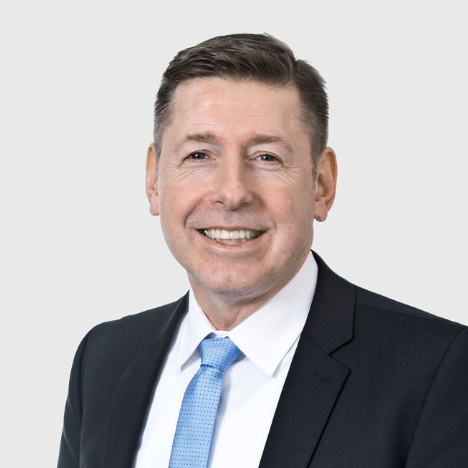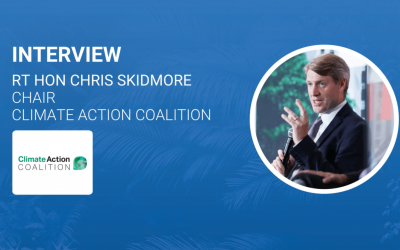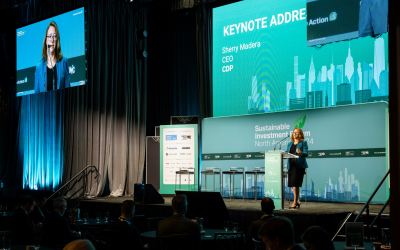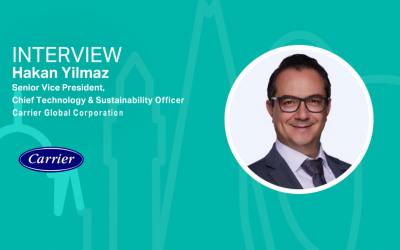Thomas Schulz on what FLSmidth is doing to meet the Paris Agreement goals
Ahead of the Industry Transition Summit, taking place on the 18 & 20 May, Climate Action caught up with Thomas Schulz, CEO at FLSmidth, to discuss what the company is doing to meet the Paris Agreement goals.

Ahead of the Industry Transition Summit, taking place on the 18 & 20 May, Climate Action caught up with caught up with Thomas Schulz, CEO at FLSmidth, to discuss what the company is doing to meet the Paris Agreement goals.
FLSmidth are our Headline Partner for our Industry Transition Summit in our Roadmap to COP26 Series. How are FLSmidth working towards the Paris Goals?
FLSmidth’s sustainability ambitions are combined under our MissionZero sustainability programme, which aims to make the technology and solutions available to reduce emissions in cement and mining to zero by 2030.
Cement and mining operations have a significant impact on the environment. With MissionZero, we take the lead in bringing these industries into a sustainable future.
Combined, cement and minerals production accounts for approximately 10% of all CO2 emissions. With growing populations, a larger middle class, and a transition to greener energy, the demand for cement and minerals - and thus the environmental impact - will only increase in the next decade.
A more sustainable future requires action from the industries. We will lead this action towards zero emissions in mining and cement, without compromising quality or our customers' commercial competitiveness.
With MissionZero, we will deliver solutions that make it possible to operate zero-emissions cement plants and manage zero-emissions mining processes. Achieving the goals by 2030 requires a paradigm shift in collaboration, innovation and adoption of new technology in the industries.
We recently joined the Science Based Target initiative and the Copper Mark – two programmes that we as being vital in creating accountability and transparency on our own journey to green, as well as central to the realisation of the Paris Agreement goals.
The Science Based Targets cover the company’s emissions throughout the value chain – from its own operations, from its supply chain and, most prominently, from its customers. The latter account for > 95% of its emissions.
FLSmidth has just announced its science based target commitments: by 2030 FLSmidth will be carbon-neutral in its own operations, have 30% of its spend with suppliers with similar decarbonisation targets, cut customer-associated emissions per revenue by 56%, or 7% year on year. These goals are on top of the MissionZero ambition to provide zero-emission technology to the mining and cement industries by 2030.
Cement and minerals production account for approximately 10% of all CO2 emissions. What are the biggest challenges you face for decarbonising each sector? How can each industry balance its role as an enabler whilst continuing to reduce its emissions?
Cement and minerals production account for approximately 10% of all CO2 emissions. What are the biggest challenges you face for decarbonising each sector? How can each industry balance its role as an enabler whilst continuing to reduce its emissions?
The cement industry contributes over 7-8% of the world’s CO₂ emissions, but demand remains high. It is, therefore, imperative that decarbonisation efforts are accelerated. But the transition to low-carbon cement production requires drastic engineering and digital solutions.
The global economic growth and urbanisation continue to increase the demand for cement. Investments in infrastructure provide people with increased mobility, better economic access, an improved quality of life and can lower inequality. However, with cement production contributing approximately 7-8% of CO₂ emissions, the path to a low-carbon, sustainable future and higher living standards does not look very green.
Cement is a carbon intensive industry, but so is the potential for decarbonization. Speeding up the green transition of cement is essential for a low-carbon future, as well as being central to the realisation of the Paris Agreement and vital to the effective implementation of green recovery packages post-Covid-19.
One of the key solutions here is finding alternative fuels. Producing cement is a very energy intensive process, demanding substantial energy to reach the heat needed for the processes involved. The combustion of fuels counts for 32% of the CO₂ emissions coming from the process. Traditionally fossil energy sources have been preferred for this process, as these provide a stable clean source of energy. But to reduce CO₂ emissions, energy substitution is required.
One energy source is the so-called Refuse Derived Fuels (RDF), where fossil fuel is substituted with the burning of garbage and used in the calcination process. We are seeing the positive effects from projects around the world; with the Vietnamese Cement company VICEM and Golden Bay Cement in New Zealand. In both cases solving two problems at the same time; you remove coal as the source of energy and you combat the waste issue at the same time.
Another CO₂ emission challenge for the cement industry is the use of clinker as the main ingredient. The calcination of the limestone clinker is actually the main source of CO₂ emission from the industry, representing as much of 57% of the total emission from the process. We want to lower the volume of clinker by accelerating deployment of clay calcination and promoting the use of clinker/clay/limestone blends to reduce emissions. The first step will be to demonstrate industrial-scale clay calcination for use as a binder, a second step is to decarbonise this process using electrification and renewable energy. Clay is particularly interesting as it is abundant in growth regions, which also face a lack of good quality limestone.
Finally, digitalisation will play a key role in bringing down emissions. We have seen under the Covid-19 pandemic a significant rise in customers interested in applying digital solutions. This, of course, is because travel restrictions are making it hard for technicians to come on site and carry out repairs and maintenance. Digitalising the cement factory processes allows you to apply energy efficiency solutions, make sure that the cement blends you use are exact by automating the sampling and testing the quality, and ensuring the right blend of the CO₂-heavy limestone clinker and other less heavy supplementary materials.
While new solutions are becoming available to reduce CO₂ emissions in the cement production, this is not enough. In order to accelerate investment by cement producers, demand for low-carbon cement needs to be stimulated through new requirements in public-procured infrastructure projects, integration of low-carbon production processes in building codes, and stimulation of green investments across the sector.
In mining, we see a projected demand for minerals that will double by 2050 and it is essential that governments and industry ensure that supply is reliable and sustainable. With a move towards energy efficiency, green technology and a low carbon future, we are seeing stronger demand for electric cars, wind and solar energy and energy storage. Meeting these demands requires minerals, which places mining industry at the centre of green-energy solutions.
The difficulty in delivering the minerals demanded by society while decreasing the environmental footprint is being compounded by declining ore grades. This has direct implications for the amounts of water and energy needed for production, increasing the environmental footprint of the mine. It is a challenge, but it also creates opportunities for us to be part of the solution.
In mining, we will focus on the entire flowsheet, but with an emphasis on areas where we see a lot of potential in terms of reducing water use, energy consumption, emissions and waste. Tailings will be central but there will be a focus on pumps, flotation and arsenic removal processes such as ROL.
The first phase in this journey has been completed and is now being operationalised. This will mean a greater emphasis will be put on those products available today in the FLSmidth portfolio that have a proven sustainability benefit.
Secondly, we will focus on demonstrating how some newer products in the portfolio support more sustainable operations through life cycle assessments and total cost of ownership analyses.
Thirdly, we will accelerate work and increase attention on several, currently available, game changers for mining, such as dry-stack tailings, ROL and IPCC.
The fourth and final piece is an R&D-based investigation into future products and processes that will know can make a significant impact on mining’s footprint.
This will happen through disruptive thinking, innovation, partnerships and co-creation that will occur within the industry, outside of the industry and together with third parties and universities across the globe. Several ideas in this category are already being explored and/or developed. And by applying a digital lens on existing solutions, we intend to find further ways to improve the miner’s footprint.
Clean energy technology requires minerals, and demand for minerals is expected to double by 2050, placing the mining industry at the centre of green-energy solutions. How can the industry balance its role as an enabler whilst continuing to reduce its emissions?
In mining, we see a projected demand for minerals that will double by 2050 and it is essential that governments and industry ensure that supply is reliable and sustainable. With a move towards energy efficiency, green technology and a low carbon future, we are seeing stronger demand for electric cars, wind and solar energy and energy storage. Meeting these demands requires minerals, which places mining industry at the centre of green-energy solutions.
The difficulty in delivering the minerals demanded by society while decreasing the environmental footprint is being compounded by declining ore grades. This has direct implications for the amounts of water and energy needed for production, increasing the environmental footprint of the mine. It is a challenge, but it also creates opportunities for us to be part of the solution.
In mining, we will focus on the entire flowsheet, but with an emphasis on areas where we see a lot of potential in terms of reducing water use, energy consumption, emissions and waste. Tailings will be central but there will be a focus on pumps, flotation and arsenic removal processes such as ROL.
The first phase in this journey has been completed and is now being operationalised. This will mean a greater emphasis will be put on those products available today in the FLSmidth portfolio that have a proven sustainability benefit.
Secondly, we will focus on demonstrating how some newer products in the portfolio support more sustainable operations through life cycle assessments and total cost of ownership analyses.
Thirdly, we will accelerate work and increase attention on several, currently available, game changers for mining, such as dry-stack tailings, ROL and IPCC.
The fourth and final piece is an R&D-based investigation into future products and processes that will know can make a significant impact on mining’s footprint.
This will happen through disruptive thinking, innovation, partnerships and co-creation that will occur within the industry, outside of the industry and together with third parties and universities across the globe. Several ideas in this category are already being explored and/or developed. And by applying a digital lens on existing solutions, we intend to find further ways to improve the miner’s footprint.
The mining and mineral processing industry is heavily dependent on water. Can you explain the challenges this presents (in reference to the decarbonisation of the industry, and its environmental impact more widely), and what FLSmidth is doing to help their customers overcome these challenges.
As ore grades decline, miners need to use more water and process more material, just to keep up with production rates, thereby creating more water and tailings to manage. Then into this mix add climate change and weather instability. Droughts and water scarcity are becoming more common, frequently putting local communities and farmers in direct confrontation with industry. At the other end of the scale, increasingly unpredictable weather patterns, such as unseasonal or especially high rainfall can create management issues when it comes to mining waste, or wet tailings.
According to a recent Moody’s report, about 70 percent of mines operated by the “Big Five” – BHP, Rio Tinto, Anglo American, Vale and Glencore –are located in countries where water stress is considered a major risk. What is required is a tricky balancing act: Shareholders, customers, employees and neighbouring communities will expect miners to not only support global development, but operate profitably and to do so while lessening the industry’s environmental footprint.
Already, a growing number of water-management solutions have been successfully deployed around the world. Some mines are already achieving a water re-circulation rate of 90% or more. New technologies are being developed, including dry processing, use of seawater or desalination of sea water (though this is often at a sizeable cost and can be a big user of power both in the desalinating process and also in terms of getting water to remote, mountainous mine sites through pipelines), filtration and water reuse and dry stacking of tailings, which is now possible for even large-scale operations.
Solving this water-based conundrum was top of the agenda just over twelve months ago when we launched MissionZero, our initiative to enable the mining industry to move towards zero water and energy waste by 2030.
Recently, driven by our MissionZero R&D focus, we launched a new development in our filter press offering, called the AFP2525 Automatic Filter Press. The AFP2525 marked a significant amelioration within FLSmidth filter press range, due to lower maintenance costs combined with the potential to recycle and reuse a significant amount water. As a result, the high-efficiency, large-capacity, dewatering equipment both reduces the need for fresh water intake and cuts costs for the mine site.
By employing a filter press to remove the water from tailings waste, miners can eliminate the need for wet tailings dams, while the reuse of process water minimises environmental impact, cuts complexity and helps attain a social licence to operate. It meets growing customer demand for fast and efficient water recovery and illustrates our determination to meet our MissionZero ambition.
Digitisation and Autonomy are a big part of FLSmidth’s long-term growth strategy to improve efficiency within MissionZero. What role will these technologies play in creating a more sustainable mining/cement industry?
Digitalisation is absolutely key to achieve sustainable and socially acceptable mining and cement production because improved sustainability and better productivity go hand-in-hand.
One of the core dimensions of being more sustainable is the digital dimension – When firms are using less power, using less water and so forth, they are having a very direct impact on reducing their costs and therefore helping the bottom line. This is a win-win.
For our own MissionZero strategy, we could not get there without the digital solutions. When you are talking about reliability, about process optimization and reducing waste, you are talking about problems that digitalization needs to be a part of in solving.
Automation also is a key to sustainable mining. It too allows mines to use fewer resources such as energy and water and to reduce emissions. Take for instance the pyro process often used in nickel, alumina, chrome, and lime industries where digital solutions can have direct impact on the pyro processing efficiency.
Advanced sensor technologies measuring both the kiln shell temperature and analysing gases such as CO, NO, SO₂, CO₂, HCl and O₂ are providing valuable parameters for an advanced process optimisation solution, contributing to a more stable operation, reduced fuel consumption and thereby reduced emissions.
Process optimisation solutions are excellent when it comes to decreasing energy consumption in minerals concentrators. Advanced and intelligent control have emerged as the digital technologies driving performance improvements, and are now generally accepted as an advantage in most modern high capacity concentrators.
The conversations addressing sustainability goals in heavy industry have begun fairly recently, but action needs to be taken as quickly as possible. Where do you anticipate the industry will be in the next 5-10 years (in terms of sustainability goals)? How can we accelerate decarbonisation and create a sense of urgency?
The conversation in both cement and mining has moved significantly over the past few years and now we are seeing a massive amount of public, transparent commitments to reduce emissions and resource use from our customers.
Perhaps we saw initial moves from cement but now the conversation in the mining industry around sustainability has also matured. It has moved from a general acknowledgment that mining must become more sustainable to a point where the industry recognises that it is now a pre-requisite for doing business. Sustainable practices are increasingly non-negotiable in order to secure investment, meet society’s evolving expectations, gain licence to operate and to ultimately ensure shareholder value.
Even faced with a climate challenge, industry still needs to make money and answer to shareholders. So the best solution is to make sustainability a business opportunity – so it makes business sense to be sustainable. This is happening and is likely to speed up change and adoption. This can happen through market and governmental demands… regulation, consumer expectations and even a shift in shareholder demands and so forth.
Adoption rates do need to quicken, however, and the urgency is perhaps only really now being understood.
It is important for industry to remain transparent and accountable on their journeys. Initiatives such as Science Based Targets are key in setting standards, securing commitments and tracking progress – this is one way to hold industry accountable for meeting the targets they are setting – some of which are, rightly, very ambitious.
Another complementary approach is that industries can come together to join independent, standards-setting bodies. In cement this is already in existence, while in mining we are seeing a growth in this area with initiatives such as sustainable aluminium, the Copper Mark and the work being done by the London Metals Exchange.
Thomas Schulz is speaking at the Industry Transition Summit next week! Register now to connect with a growing network of key players in industry and harder to abate sectors to further drive decarbonisation through policy and regulation, to innovation, technology and investment.






